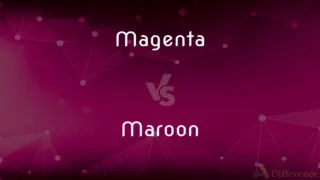Melting vs. Dissolving — What's the Difference?
By Fiza Rafique & Urooj Arif — Updated on April 18, 2024
Melting is the physical change of a substance from solid to liquid by heat, while dissolving involves a substance (solute) integrating into a solvent, forming a solution.

Difference Between Melting and Dissolving
Table of Contents
ADVERTISEMENT
Key Differences
Melting occurs when a solid substance reaches its melting point and transitions into a liquid, influenced by temperature. Dissolving, on the other hand, involves a solute being incorporated into a solvent, often without a change in temperature. This process creates a homogeneous mixture or solution.
In melting, the structural integrity of the solid changes as it becomes a liquid; the molecular bonds are loosened but not broken completely. Whereas in dissolving, the solute particles separate and disperse evenly throughout the solvent, often involving interaction at the molecular or ionic level that can include breaking of bonds.
A key characteristic of melting is that it is a reversible physical change. The melted substance can be solidified again by cooling. Dissolving can also be reversible, such as in the evaporation of water from a salt solution, but it depends on the nature of the solute and solvent involved.
Melting requires energy typically in the form of heat, directly affecting the solid's thermal energy. Dissolving may involve heat absorption or release, known as the heat of solution, but this is not always necessary for the process to occur.
While melting only involves pure substances, dissolving requires at least two different substances: a solute and a solvent. This distinction highlights their fundamental operational differences in chemical and physical processes.
ADVERTISEMENT
Comparison Chart
Definition
Transition of a substance from solid to liquid
Incorporation of a substance into another
Key Substance
Single pure substance
Two or more substances (solute and solvent)
Energy Change
Usually requires heat input
May involve heat absorption or release
Reversibility
Generally reversible
Conditionally reversible
Result
Liquid form of the same substance
Homogeneous mixture or solution
Compare with Definitions
Melting
Involves only one substance undergoing a phase change.
Pure gold melts at 1064°C.
Dissolving
Interaction at molecular or ionic levels.
Electrolytes dissolve in water and disperse ions.
Melting
Observable in everyday life and various industrial applications.
Snow melts into water during a warm day.
Dissolving
Can involve solid, liquid, or gas solutes.
Carbon dioxide dissolves in water under pressure to form soda.
Melting
The process of a solid becoming a liquid when heated.
Ice melts into water at 0°C.
Dissolving
Fundamental for biological and chemical processes.
Oxygen dissolves in blood, crucial for cellular respiration.
Melting
Requires reaching a specific temperature known as the melting point.
The melting point of iron is around 1538°C.
Dissolving
The process where a solute mixes with a solvent to form a solution.
Salt dissolves in water to make brine.
Melting
Energy-driven physical change, predominantly through heat.
Chocolate melts quickly in your palm due to body heat.
Dissolving
Does not require a change in temperature to occur.
Sugar dissolves in iced tea as well as in hot tea.
Melting
Melting, or fusion, is a physical process that results in the phase transition of a substance from a solid to a liquid. This occurs when the internal energy of the solid increases, typically by the application of heat or pressure, which increases the substance's temperature to the melting point.
Dissolving
To cause to pass into solution
Dissolve salt in water.
Melting
To be changed from a solid to a liquid state especially by the application of heat.
Dissolving
To reduce (solid matter) to liquid form; melt.
Melting
To dissolve
Sugar melts in water.
Dissolving
To cause to lose definition; blend or blur
"Morality has finally been dissolved in pity" (Leslie Fiedler).
Melting
To disappear or vanish gradually as if by dissolving
The crowd melted away after the rally.
Dissolving
To cause to disappear or vanish; dispel
The sun dissolved the fog. That remark dissolved the tension in the room.
Melting
To pass or merge imperceptibly into something else
Sea melted into sky along the horizon.
Dissolving
To break into component parts; disintegrate
The deal dissolved the company into three separate businesses.
Melting
To become softened in feeling
Our hearts melted at the child's tears.
Dissolving
To bring to an end, as by breaking up; terminate or annul
"General de Gaulle was returned to power ... with a mandate to dissolve an overseas empire that had turned into a nightmare" (Alison Jolly).
Melting
(Obsolete) To be overcome or crushed, as by grief, dismay, or fear.
Dissolving
To dismiss (an assembly such as a legislative body).
Melting
To change (a solid) to a liquid state especially by the application of heat.
Dissolving
To cause to be moved emotionally or upset.
Melting
To dissolve
The tide melted our sand castle away.
Dissolving
To pass into solution
Salt dissolves easily in water.
Melting
To cause to disappear gradually; disperse.
Dissolving
To become liquid; melt
The clumps of snow dissolved into puddles.
Melting
To cause (units) to blend
"Here individuals of all races are melted into a new race of men" (Michel Guillaume Jean de Crèvecoeur).
Dissolving
To lose definition; become blurred or indistinguishable
"The last shadows have dissolved into darkness" (Daniel Blajan).
Melting
To soften (someone's feelings); make gentle or tender.
Dissolving
To become disintegrated; disappear
The mist dissolves as the sun rises.
Melting
A melted solid; a fused mass.
Dissolving
To be broken up into separate parts
The empire dissolved into many separate countries.
Melting
The state of being melted.
Dissolving
To be brought to an end; be annulled or terminated
After a long separation, the marriage finally dissolved.
Melting
The act or operation of melting.
Dissolving
To be moved or overcome emotionally
I dissolved into helpless laughter.
Melting
The quantity melted at a single operation or in one period.
Dissolving
To make a transition between shots in a cinematic work using a superimposition in which the first shot fades out while the second shot gradually appears.
Melting
A usually open sandwich topped with melted cheese
A tuna melt.
Dissolving
A transition in a cinematic work consisting of a superimposition in which the first shot fades out while the second shot gradually appears. Also called lap dissolve.
Melting
Present participle of melt
Dissolving
Present participle of dissolve
Melting
Which is melting, dissolving or liquefying.
Dissolving
The act by which something dissolves.
Melting
Given over to strong emotion; tender; aroused; emotional, tearful.
Dissolving
Melting; breaking up; vanishing.
Melting
That causes one to melt with emotion; able to make others feel tender and emotional.
Dissolving
The process of going into solution;
The dissolving of salt in water
Melting
The process of changing the state of a substance from solid to liquid by heating it past its melting point.
Dissolving
Causing to dissolve;
The dissolving medium is called the solvent
Melting
(figurative) The act of softening or mitigating.
Melting
Liquefaction; the act of causing (something) to melt, or the process of becoming melted.
Melting
Causing to melt; becoming melted; - used literally or figuratively; as, a melting heat; a melting appeal; a melting mood.
Melting
The process whereby heat changes something from a solid to a liquid;
The power failure caused a refrigerator melt that was a disaster
The thawing of a frozen turkey takes several hours
Melting
Becoming liquid
Common Curiosities
What happens to molecular bonds during melting?
During melting, the molecular bonds within a substance loosen but remain intact, allowing the substance to change from solid to liquid.
What is meant by the melting point of a substance?
The melting point is the specific temperature at which a solid substance turns into a liquid under normal atmospheric pressure.
What is a supercooled liquid?
A supercooled liquid is a state where a liquid is cooled below its freezing point without it becoming a solid.
What is the heat of solution?
The heat of solution is the amount of heat energy absorbed or released when a solute dissolves in a solvent, affecting the temperature of the solution.
Can dissolving be considered a method of mixing?
Yes, dissolving is a method of mixing where the solute particles are evenly distributed throughout the solvent, forming a homogeneous mixture.
Can all solids dissolve in liquids?
Not all solids can dissolve in all liquids; the ability of a solid to dissolve depends on its chemical properties and the nature of the liquid.
Does dissolving change the chemical composition of a solute or solvent?
Dissolving generally does not change the chemical composition of the solute or solvent; it merely distributes the solute molecules within the solvent.
Are there substances that can dissolve without a solvent?
No, dissolving inherently requires a solvent; the process involves a solute integrating into a solvent to form a solution.
Can the process of melting be fast-tracked?
The melting process can be accelerated by increasing the temperature or reducing the melting point through the use of certain chemicals or pressure changes.
What are examples of common solvents?
Water, alcohol, and acetone are common solvents, each capable of dissolving various solutes depending on their chemical compatibility.
How is saturation related to dissolving?
Saturation occurs when a solvent contains the maximum amount of a solute that it can hold at a given temperature and pressure, beyond which no more solute can dissolve.
What is sublimation in the context of phase changes?
Sublimation is the transition of a substance directly from solid to gas without passing through the liquid phase, such as dry ice turning into carbon dioxide gas.
Why do some substances melt at lower temperatures under pressure?
Some substances melt at lower temperatures under pressure due to the unique arrangement of their molecules, which are influenced differently by external pressure.
How does agitation affect the dissolving process?
Agitation, such as stirring, can increase the rate of dissolving by spreading the solute particles more quickly throughout the solvent.
What is an example of a reversible dissolving process?
An example of a reversible dissolving process is the dissolution and subsequent recrystallization of salt in water, where evaporating the water leaves behind solid salt.
Share Your Discovery

Previous Comparison
Knowledge vs. Skill
Next Comparison
By vs. ThroughAuthor Spotlight
Written by
Fiza RafiqueFiza Rafique is a skilled content writer at AskDifference.com, where she meticulously refines and enhances written pieces. Drawing from her vast editorial expertise, Fiza ensures clarity, accuracy, and precision in every article. Passionate about language, she continually seeks to elevate the quality of content for readers worldwide.
Co-written by
Urooj ArifUrooj is a skilled content writer at Ask Difference, known for her exceptional ability to simplify complex topics into engaging and informative content. With a passion for research and a flair for clear, concise writing, she consistently delivers articles that resonate with our diverse audience.














































